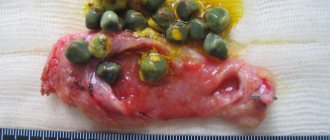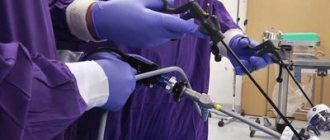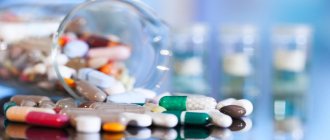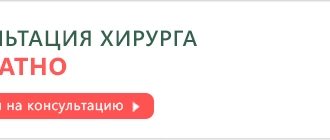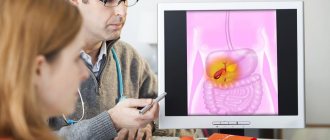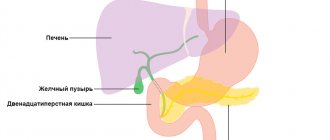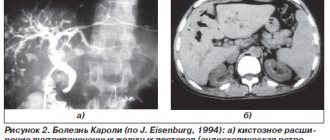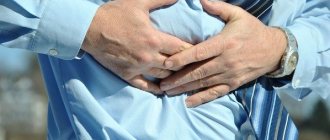When a patient first consults a specialist about biliary colic, this does not mean that an acute pathological process is already underway in the body. Most often, the examination results determine chronic cholecystitis, the treatment of which takes quite a long time.
Symptoms of cholecystitis develop gradually, so often an attack of biliary colic is an exacerbation of the chronic form of a latent gallbladder disease.
In most cases, chronic cholecystitis manifests itself:
- pain in the right hypochondrium;
- decreased appetite;
- bitterness in the mouth;
- nausea, less often - morning vomiting of bile.
During exacerbations of the disease, attacks of cutting pain in the epigastric region or in the right hypochondrium are observed.
The pain can radiate upward and to the right - to the area of the right shoulder blade, right shoulder, right half of the neck. In some cases, pain spreads throughout the abdomen, intensifying when lying on the left side and taking deep breaths.
Functions of the liver and gallbladder
You may not think about your organ health until you experience pain or digestive problems. The gallbladder is very small by the standards of the rest of the body: it is pear-shaped and located in the upper right corner of the abdomen, under the liver. In fact, it is a storage facility for digestive fluid - bile. When you eat fatty foods, the liver produces bile, a thick, viscous yellow-green fluid that helps the body break down fats, absorb fat-soluble vitamins and some minerals, and synthesize and eliminate cholesterol .
It is synthesized in liver cells, flows down the ducts and accumulates in the gallbladder, and then is released into the small intestine through the common bile duct - common bile duct. Bile saponifies fats, breaking them into tiny droplets, which are absorbed by the intestinal wall and used by the body for various purposes. Without it, dietary fat is absorbed extremely poorly, remains in the intestinal lumen and forms “fatty” stool.
The gallbladder in our body has a strictly defined function - to store and store bile between meals, but we can live without it if it is damaged and needs to be removed. After its removal, natural discomfort occurs and a diet is required.
Gallbladder diseases
The patient's first visit to the doctor about biliary colic does not mean that he has an acute process. Almost always, a thorough examination reveals signs of chronic suffering of this organ. In other words, cholecystitis develops gradually and therefore an acute attack of cholecystitis is an exacerbation of a chronic, latent disease of the gallbladder.
In chronic cholecystitis, the most common symptoms are indications of pain in the right hypochondrium, bitterness in the mouth, poor appetite, nausea, and sometimes vomiting bile in the morning.
Exacerbation of the disease is accompanied by attacks of unbearable cutting pain in the right hypochondrium or in the epigastric region. The pain has a typical irradiation (direction) - up, to the right and behind - to the area of the right shoulder blade, to the right shoulder, to the right half of the neck, sometimes spreads throughout the abdomen, intensifies with a deep breath, in a position on the left side. The pain syndrome may be accompanied by nausea and repeated vomiting mixed with bile, which does not bring relief. Pallor and yellowness of the skin are noted. The tongue is coated with a yellow-brown coating and is rather dry. The mobility of the abdominal wall in the upper part on the right is limited. Here, an area of increased skin sensitivity, pain on palpation (pressure), and sometimes a symptom of muscle protection are determined.
It must be emphasized that the localization of pain in the right half of the chest, the right shoulder blade is as characteristic of diseases of the gallbladder as pain behind the sternum and in the left arm is characteristic of coronary heart disease. It is important to find out the immediate, provoking cause of the pain syndrome. An attack of cholecystitis is most often associated with the abuse of fatty foods and other eating errors. A relapse of an attack is most often caused by a stressful situation, nervous tension, or mental trauma. In persons suffering from cholelithiasis, pericholecystitis, an attack more often occurs due to physical stress, horse riding, cycling, or driving a car on bumpy roads.
Transient jaundice that develops after an attack is characteristic of cholelithiasis, but can also occur with hypermotor dyskinesia. In some cases, when the outflow of bile is impaired, patients note the appearance of discolored feces (white-gray) within 1-2 days.
With uncomplicated cholelithiasis, an attack of pain begins suddenly and just as suddenly stops; the patient feels quite satisfactory the very next day.
More often, chronic diseases of the biliary tract occur with so-called minor symptoms - general malaise, low-grade fever, mild dyspeptic symptoms, pain or discomfort from the heart. Such patients spend a long time, but unsuccessfully, visiting doctors of various specialties, who sometimes mistakenly diagnose rheumatism, thyrotoxicosis, neurocirculatory dystonia, peptic ulcer, gastritis, neuralgia, etc., while the cause of all these symptoms lies in latent cholecystitis, dyskinesia or cholelithiasis. It may be the other way around, the patient is being treated for various diseases of the gallbladder, but in fact the true cause is duodenal ulcer.
In elderly and senile people, a painless course of cholecystitis occurs, which is associated with a change in the threshold of pain sensitivity and unresponsiveness of the body in old age.
In patients with chronic diseases of the biliary tract, the stomach may be involved in the process, and belching, bitter taste in the mouth, heartburn, nausea, and anacidity are often noted. Possible bowel problems (diarrhea, constipation). All these disorders affect the state of the central nervous system; patients become nervous, irritable, and suffer from insomnia. And, conversely, people suffering from chronic diseases of internal organs may develop dyskinesia of the gallbladder.
Hypotonic (atonic) dyskinesia is usually characterized by weak, dull pain (a feeling of heaviness) in the right hypochondrium. The pain is usually accompanied by nausea when eating, an unpleasant taste in the mouth, and poor tolerance to food odors.
Who's at risk
Although gallbladder inflammation can occur at any age, from infants to the elderly, some people are more likely to suffer from this pathology than others. There are certain risk factors that create an increased susceptibility to diseases in a person.
Female
In women, due to the characteristics of hormonal metabolism, bile flows from the liver and gallbladder worse; after 35-40 years, the fair sex more often suffers from cholelithiasis and cholecystitis.
Excess weight
Against the background of obesity, bile is produced more densely, it copes worse with the digestion of fats. The liver works under increased load, and bile usually contains more cholesterol.
Genetic predisposition
If your mother or grandmother, grandfather or sibling has gallstone disease, you are also at risk.
Age over 40
The body ages, and the liver copes with its duties worse, the composition of bile changes, and a predisposition to the formation of stones arises.
Patient Reminder
Treatment for dyskinesia depends on its type. With hypomotor bile ducts, it is important to activate the motility of the gallbladder and its ducts. For this purpose, choleretic drugs are usually used. For the hypermotor type, antispasmodics are mainly prescribed, which help relax the bile ducts and reduce pain.
For people suffering from the hypermotor type of dyskinesia, doctors recommend remembering the rule of the three Fs. It is as follows: fatty, fried and egg yolks should be excluded from the menu - while consuming such foods and dishes, patients usually become ill. If you have a hypomotor type, you can eat eggs.
With the hypermotor type, the diet should contain a lot of foods rich in magnesium - it helps reduce spasms. These include buckwheat, millet, whole grain bread (but not baked goods!), and greens.
| Drugs | |
| Choleretic | Antispasmodics |
Remember, self-medication is life-threatening; consult a doctor for advice on the use of any medications.
Buy the printed version of the directory at kiosks in your city or order it from the editorial office by phone or email [email protected] with the mark PM (indicate your full name, postal address and telephone number in the letter).
Dyskinesia
The disease develops when bile stagnates, when the motor function of the gallbladder and ducts is impaired. The bile thickens, which can lead to the formation of stones. In addition, there is a metabolic failure, digestive disorders, patients complain of diarrhea or constipation. Appetite also decreases, there is nausea and vomiting, pain on the right under the ribs (the pain is not sharp, not sharp). Stagnant processes can be caused by the abundance of fatty and unhealthy foods in the diet, the presence of parasites in the body, and individual reactions to specific foods.
There are two forms of dyskinesia:
- Hypotonic (or hypokinetic). The outflow of bile is weak, slow, the sphincter is not in good shape. Patients feel heaviness on the right side, prolonged aching pain, a bitter taste in the mouth, and complain of indigestion, belching, and nausea. On ultrasound, the gallbladder appears enlarged, stretched and drooping.
- Hypertonic (or hyperkinetic). The sphincter is toned, the outflow of bile is active and sharp. Pain can be associated not only with eating, but also with increased physical activity, for example, running, and sometimes appears even at rest. Ultrasound showed no changes in the size and shape of the gallbladder.
Preparing an adult for a gallbladder diagnosis
All examinations are performed on an empty stomach - at least 6 hours must have passed since the last meal. Before an ultrasound examination, exclude milk, legumes, carbonated drinks and other foods that cause flatulence from the diet. Sometimes your doctor may prescribe absorbents.
A few days before duodenal intubation, they begin to follow a diet and stop taking medications: laxatives, choleretic, vasodilators. Before the procedure, you usually drink mineral water with xylitol to enhance the secretion of bile.
Good to know
Heartburn after eating: three factors that most often provoke it
Popular questions and answers
Gallbladder diseases are becoming more common, even in young patients (18–35 years old). Therefore, many are interested in what tests need to be taken to check the gallbladder . Our experts answer questions about the diagnosis of gallbladder diseases: therapist, gastroenterologist Abdul Gamidov and Ph.D., gastroenterologist-hepatologist Olga Arisheva .
Where is the gallbladder located?
The gallbladder is located on the right in the abdominal cavity, most often under the liver, along the right costal arch, and partially contacts the anterior wall of the abdomen. The spatial location of the gallbladder in the abdominal cavity depends on the age and physique of the person.
How do you know if your gallbladder or any other organ is hurting?
With gallbladder diseases, patients complain of pain in the right hypochondrium. The problem is that similar sensations occur with some diseases of the stomach and intestines. However, pain in gallbladder pathologies is usually associated with dietary errors. If a person’s right side hurts after fried, fatty, spicy or smoked food, then most likely the problem is in the gallbladder. With biliary dyskinesia, attacks of pain often occur due to stress and after taking certain medications (estrogens, somatostatin)1,2.
Nevertheless, you should not engage in self-diagnosis, much less prescribe treatment for yourself. This is ineffective and in some cases life-threatening. Pain and discomfort in the right hypochondrium is a reason to consult a doctor as soon as possible.
Which doctor checks the gallbladder?
In chronic and mild forms of the disease, treatment and observation is carried out by a gastroenterologist. In severe cases (large stones or movement of stones through the gallbladder), a surgeon may be involved. In this case, options for surgical intervention will be considered - possibly emergency or planned removal of the damaged organ.
Sources
- Diseases of the biliary tract. Tutorial. Irkutsk IGMU 2020.
- Clinic and diagnosis of diseases of the biliary tract and pancreas. Educational and methodological recommendations. Prof. A. V. Tkachev. Rostov State Medical University. https://rostgmu.ru/wp-content/uploads/2020/03/%D0%9C%D0%95%D0%A2%D0%9E%D0%94% D0%98%D0%A7%D0%9A %D0%90_%D0%97%D0%96%D0%9F_%D0%A5%D0%9F.pdf
- Methods for examining patients with gallbladder pathology.
- Clinical recommendations. Treatment of cholecystitis. https://www.gastro.ru/userfiles/R_%D0%9B%D0%B5%D1%87%D0%B5% D0%BD%D0%B8%D0%B5%20%D1%85%D0% BE%D0%BB%D0%B5%D1% 86%D0%B8%D1%81%D1%82%D0%B8%D1%82%D0%B0.pdf
Cholecystitis
This term refers to the inflammatory process that occurs on the walls of the gallbladder. It comes in two forms - acute and chronic.
Acute cholecystitis, that is, the one that is detected for the first time, is characterized by severe, sharp pain under the ribs on the right side. It can radiate to the shoulder and even to the back, symmetrically to the place where the gallbladder is located. Accompanied by nausea, vomiting, stool upset, general intoxication (manifested by weakness, fever).
Chronic cholecystitis occurs only against the background of diagnosed acute cholecystitis. It is characterized by dull, aching pain radiating to the same right side, a bitter taste appears in the mouth, and patients complain of nausea.
